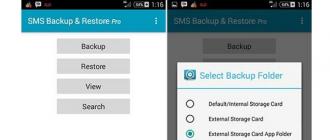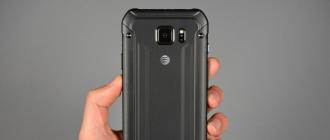Perhaps you just became the object of a joke of your comrades - then it will be a one-minute task to restore the desktop. But it is also possible that this is the work of a virus. In this case, you will have to tinker a little, but it is still fixable.
So, if you happen to be the object of the drawing, then most likely the first option will suit you.
Option 1. Display desktop icons.
Right-click on an empty space on the desktop (I think it won't be difficult to find an empty space). Select "Arrange icons" and check the item "Display desktop icons"
The result will not appear immediately, but with a delay of 3 - 10 seconds, it all depends on the performance of your computer. If it doesn't help, go to option 2.
But before doing the steps below, check your computer for viruses. Otherwise, you will correct errors, and after rebooting the system everything will remain as it was.
Option2. Launching the explorer.exe process manually.
One of the tasks of explorer.exe is to display the desktop.
1. Press the saving key combination "Ctrl" + "Alt" + "Delete".
4. In the "Create a new task" window in the "Open" field, type the command explorer.exe and click "OK".
5. Restart your computer.
If an error occurs that the explorer.exe file was not found, or the problem persists after restarting, then we will try to restore the system, i.e. go to option 3.
Option 3. System Restore.
1. Press the same "Ctrl" + "Alt" + "Delete" again.
2. In the "Dispatcher windows tasks", go to the" Applications "tab and click the" New task ... "button.
4. In the "Create a new task" window in the "Open" field, type the command% SystemRoot% \\ system32 \\ restore \\ rstrui.exe and click "OK".
The System Restore window appears:

If control points no, then most likely you have disabled the option to create control points and you will have to go to the fourth option.
Option 4. Editing the registry.
If the system restore did not help and you still do not display the desktop shortcuts, you will have to launch the system registry editor.
1. Press all the same "Ctrl" + "Alt" + "Delete".
2. In the "Windows Task Manager" window, go to the "Applications" tab and press the "New task ..." button.
3. In the "Create a new task" window in the "Open" field, type the command regedit and click "OK". The "Registry Editor" window appears:

4. Sequentially expand the registry keys to the "Image File Execution Options" section:
HKEY_LOCAL_MACHINE / SOFTWARE / Microsoft / WindowsNT / CurrentVersion / Image File Execution Options /
5. Open the "Image File Execution Options" section and look for the "explorer.exe" and "iexplorer.exe" subsections. If any of the subsections is found, then it must be deleted.
6. Click on the subsection right click mouse and in the menu that opens, select the "Delete" item and confirm the request.
9. Now let's check the parameters for launching explorer.exe by expanding the registry keys to the "Winlogon" section:
HKEY_LOCAL_MACHINE / SOFTWARE / Microsoft / WindowsNT / CurrentVersion / Winlogon /
10. Left-click on the "Winlogon" section and find the "Shell" parameter on the right side of the registry editor window.
11. Right-click on this parameter and select the "Change" menu item.
12. In the window "Changing the string parameter" in the value field should be written as explorer.exe and nothing else, if this is not the case, then fix it.
13. Click the "OK" button, close all windows and restart the computer.
This problem will clearly strike your eye - after all, right after the usual start window operating system, you will be greeted by an inhospitable black screen on which the mouse cursor will wander lonely.
The most likely cause of this issue is malware infection.
The essence of the problem boils down to the fact that viruses can modify the system registry, or rather the section responsible for the correct operation of the desktop. At the same time, shortcuts and files located on the desktop will not be available to you. Antiviruses are able to solve the problem and rid the system of the virus, however, not all programs can return the registry value that is responsible for the system interface to its original position.
Actions to solve the problem
To use the desktop again, you need to perform a few simple manipulations. First go to the task manager. To do this in Windows 7, use the keyboard shortcut Ctrl + Shift + Esc... In the manager, open the menu " File"And click on the item" Execute».
A window will open in the field of which enter “ explorer.exe". This is the name of the file responsible for the functioning of the desktop. It remains to click OK and after a moment the table and all the shortcuts and files located in it will again open to your eyes.
How to prevent the subsequent occurrence of the problem
There are several ways to prevent this error from recurring. First, let's look at a simpler one, namely work with the "Startup" folder. This folder, located in the Start menu, can serve as a repository of individual shortcuts that you want to launch after the next system startup.
In order to start the desktop the next time you start, you need to open the "Startup" folder (in the "Start" menu, click on the "All Programs" item and find it among other directories) and the C: \\ Windows folder. From the latter, you will need a file signed as "explorer.exe". Find the item "Create shortcut" by right-clicking on the file. This shortcut must be placed in the "Startup" folder. After doing this manipulation, restart your computer. If the problem has not been resolved, then the following methods of solving the problem may help you.
Modifying registry data
Making changes to windows registry 7. To call it, use the Win + R key combination. A new window will ask you to enter the name of the program to run, in our case it will be "Regedit".
The left field of the registry will represent the root system of the folders. In it, you need to open the HKEY_LOCAL_MACHINE \\ SOFTWARE \\ Microsoft \\ Windows NT \\ CurrentVersion \\ Winlogon folder. Here we are interested in the Shell file, in which we need to enter one of the values: "C: \\ Windows \\ explorer.exe" or "explorer.exe". 
Once you've made your changes, it's worth deleting a few folders. In the CurrentVersion directory, find the Image File Execution Options folder. Here you need to get rid of the items "iexplorer.exe" and "explorer.exe". Following this, restart your computer. If the problem persists, try the next method.
Antivirus will help 
To work you need an AVZ antivirus. He will help you reset the settings and return system files to the original position. The program can be downloaded on the Internet at the official website.
The application should be run as administrator, this can be achieved by right-clicking on the "avz.exe" file and selecting the line " Run as administrator". In the application, select the button " File". Next, look for the item " System Restore". On the monitor, you will see a window in which you need to mark the first item (restore the file launch parameters), the fifth (restore the desktop settings) and the sixteenth (restore the Explorer launch key).
If you wish, you can select other items in the menu that appears, we recommend that you check the boxes opposite, from the sixth to the tenth, menu items. They will be executed full check and correction of the difficulties encountered. The number of selected sub-items will determine the amount of virus diagnostics, and, consequently, the performance of your computer in the future.
But remember, the more items were selected, the longer the antivirus will perform its work. So, if the only task is to return the working table to work, then you can limit yourself to the first recommendations (points 1, 5 and 16).
Once you have decided on the test configuration, click on the " Perform marked operations". After confirming the operations, the application will start its work. The speed of operation depends on your system configuration and the number of items checked in the selection. As a result, the operating time can range from a few seconds to 15-20 minutes. The program will notify you about the end of the system recovery with a separate window.
After checking with this antivirus utility, you need to restart your computer and see what the result was. There is no 100% guarantee of getting rid of the virus, however, aVZ program is considered to be one of the most successful in recovering the system after a viral " invasions". If desired result failed, the only way out is to reinstall the Windows system.
In contact with
Good day. Another instruction on the topic of eliminating the consequences of a virus attack on your computer. Today we have another problem under consideration - the desktop does not start. On modern operating systems, only a picture of the desktop is usually shown, in older operating systems it may already be just black on the whole screen. I will try to describe all the steps to try to restore your computer to work. If they do not help, then it is most likely necessary to reinstall the system. And yes, before following this instruction, you need to clear the computer of virus, otherwise all our treatment will be nullified by the virus, by constant changes in the direction it needs. For cleaning, you can use one of the LiveCDs: Dr.Web LiveDisk or Kaspersky Rescue Disk. They can be written to a USB flash drive or disk on a working computer and used to disinfect the computer.
1. We are trying to start the desktop.
Of course, the first thing we need to do is try to launch your desktop (and in some cases, the real desktop, since a certain category of pests can launch a modified desktop). And there are two options for that:
In the window that opens, click on the "File" tab and select "Run a new task".

In the window that opens, we also enter explorer.exe or C: \\ Windows \\ explorer.exe and click OK.

We look at the result, if the desktop has loaded, we breathe a sigh of relief, there is a little work left, go to step 3. If not, then the problem is more complicated, the pest has replaced the executable file of the desktop with its own and we need to restore it, which means we read on.
2. We are trying to restore the original explorer.exe file
So how do you restore the executable file? The first is to try to restore using the command line and the sfc utility. To do this, we need a command line running as an administrator, so we use the second method of the first step, but in the task launch window we put a checkmark in front of “ Create a task with administrator rights", And in the field we enter cmd.

In the window that opens, enter sfc / scannow and press the Enter key.

We are waiting for the end of the check, restart the computer and see the result. If the desktop does not start, then you will have to restore the file manually and for this we again need a working computer with the same operating system (bit and preferably edition (Professional, base, Enterprise) and a flash card. Copy the file C: \\ Windows \\ explorer.exe on a clean computer to a USB flash drive and insert it into the infected PC. Next, we do a tricky manipulation.
- Launch "Run" or "Task Manager" → open "file" → "Start a new task"
- Click on the "Browse" button
- Go to the flash drive and copy the explorer.exe file
- go to C: \\ Windows and paste, agreeing to replace the file. (If he writes something about the impossibility due to insufficient access rights, open the file properties in the C: \\ Windows folder, select "Security", at the bottom click on the "Advanced" button, at the top on the "Owner" line, click on "Change", click "Advanced", the "Search" button, select "Administrator" and click OK until all the properties windows are closed, after that we again copy the file from the USB flash drive and paste it into the system directory)
And now, we try to repeat the first point of the instruction, if the desktop has loaded, go to the third point, if not, we reinstall the system.
3. We work in the registry to restore the original values.
It remains to clean the registry, for this in the "Run" utility or the task manager, enter the command regeditand click OK.
In the window that opens, go to the directory:
HKEY_LOCAL_MACHINE \\ SOFTWARE \\ Microsoft \\ Windows NT \\ CurrentVersion \\ Winlogon
And we are looking for a parameter Shell, it should have a value exolorer.exe as in the screenshot below, if this is not the case, we fix it. If there is no parameter, you can create it (this is a string parameter) via the context menu.

HKEY_LOCAL_MACHINE \\ SOFTWARE \\ Microsoft \\ Windows NT \\ CurrentVersion \\ Image File Execution Options \\ explorer.exe
HKEY_LOCAL_MACHINE \\ SOFTWARE \\ Microsoft \\ Windows NT \\ CurrentVersion \\ Image File Execution Options \\ iexplore.exe
They need to be removed. It is the branches, not the parameters in them. With a high degree of probability, the virus wrote data in them so that your desktop does not start, and the system itself will create new branches at startup, only with the parameters it needs.

4. Restart
We restart the computer and see the result, if everything went well. The system will start and will work as if nothing had happened. If not, then it is already easier to reinstall the system.
Look like that's it. I hope this article was useful to you, click one of the buttons below to tell your friends about it. Also subscribe to site updates by entering your e-mail in the field on the right or by subscribing to the Vkontakte group and YouTube channel.
Working with a computer is based mainly on interaction with the desktop, on which the most frequently used programs and folders are located. But what to do if a worker is missing windows table 7? Where can I find my lost folder?
Run the folder
Explorer.exe - the process responsible for displaying the desktop on Windows. If this process fails while working on the computer, the entire interface disappears and only a picture remains (sometimes even a black screen). The reasons for this behavior of the system can be both normal problems and serious failures. In any case, the problem is solved quite simply.Desktop is an ordinary folder, the work of which is initiated by the explorer.exe process. Therefore, the answer to the question of how to restore the Windows 7 desktop is obvious - you just need to start the process.
This method is relevant only if the folder and the path to it are not damaged, otherwise explorer.exe will not work correctly.
There are two ways to restore the work of the process:
- Through the task manager;
- Through the command line.
The first way
For it, you need to call the task manager with the Ctrl + Alt + Delete combination and click on the "File" control panel:Select "Create a new task" and drive explorer.exe into the window that appears. After this action, the desktop should appear. If this did not happen, then we use the second option.
Second way
To implement the process recovery through the console, you must run a command line with administrator rights. To do this, press WIN + W and enter "Command line" in the search bar. Right-click the manipulator and select "Run as administrator":

Enter explorer.exe into the console without any commands. The program will automatically start the process, if successful, all desktop icons will reappear:

Recovery tool
If the above method did not help or Windows boots up to a black screen on which no action can be performed, then you will have to use the recovery tool to return the desktop:
In this case, you can choose to run Last Known Good Configuration. However, the method is not reliable if the computer is infected with a virus program.
We launch the device in safe mode and call the Task Manager again . We repeat the algorithm, starting a new process through modal window... But in this case, we need the rstrui.exe command:

This command will launch the system restore utility, which will allow you to select a rollback point, which will return the computer to the date and time the point was created.
You don't have to create rollback points yourself. Windows does this automatically, as soon as the user installs programs that affect the system, updates drivers, etc.
The rstrui.exe process, similar to explorer.exe, can also be launched through Command line with administrator rights.
This method allows you to restore the desktop even when the explorer.exe file is damaged / deleted / changed.
After rollback, be sure to check the system for malware, since there is a high probability that the problem lies in them.
We work with the registry
Registry is a database of all parameters assigned to the system. This is where all viruses are first registered, changing values \u200b\u200band rewriting paths. Of course, you can load the last known good configuration or roll back the system, however if the device starts up in normal operation, but without a desktop, then it's faster to check everything yourself:

As a precaution, before manipulating the registry, it is recommended to do backup on a third-party media (flash drive or disk). So, if the values \u200b\u200bare changed incorrectly, you can easily restore the previous copy and start over.
Final computer cleanup
As soon as Windows has loaded and the desktop has not disappeared, you can start cleaning up the system, which will finally get rid of this incident:- We load the antivirus with a new database on an external medium;
- We are looking for a file on the Internet called explorer.exe, download and upload it to the USB flash drive where the antivirus is located;
- Using the latter, we check the computer and delete all suspicious utilities and files;
- We are looking for explorer.exe on the computer (the search is carried out in the section where the operating system is installed) and change it to a file downloaded on the network (after checking it with an antivirus);
- We reboot the device.
It is possible that Windows Remote Desktop does not work due to a graphics card failure. Do not forget to update your video and audio drivers after restarting.
Video instructions for restoring the desktop
The video shows the main methods of recovery in case Remote Desktop does not work:Restoring the desktop is not difficult and fast enough. The most difficult procedures will be finding the cause, ways to solve them and finally cleaning up the computer manually or with special utilities.
Sometimes computer users are faced with the fact that after windows boot the desktop does not load... The operating system has loaded, but only background picture - no icons, no bottom panel at all. What to do in this case?
If your desktop does not load, it means that the explorer.exe process failed... Running this process will return the desktop to its place, but after that you will need to figure out the reasons for the "disappearance" of the desktop and eliminate them.
So to execute the explorer.exe process, you will need to invoke Windows. This is done using the keyboard shortcut Ctrl + Alt + Delete (Ctrl + Shift + Escape for Windows 7). When the Task Manager opens, on the File menu, select the New Task (Run ...) option. In the window that opens, you will need to enter explorer.exe and click on the OK button. You can not enter the command manually, but use the Browse button, go to wINDOWS folder on the C drive, select the explorer.exe file, click on the Open button, and then on the OK button.
These steps will help to return all the icons and panels of the desktop to their place, but they will not fix the reason why the desktop does not load, and the problem will repeat every time the operating system is loaded. How to deal with the problem once and for all?
The most likely reason that your desktop does not want to load is virus in the system... So first you need to scan the system with an antivirus (best of all, except for the installed antivirus use one or more - if the antivirus has already allowed the virus into the system, it may not even notice it). But sometimes, even after removing all viruses, the desktop still does not load. In this case, you will have to resort to editing the Windows registry.

To run registry editor, you need to click on the Start button and select the Run option (you can simply use the Win + R keyboard shortcut). In the window that opens, enter the regedit command and click on the OK button or the Enter key.
In the registry editor you need to check the presence of the following keys:
HKEY_LOCAL_MACHINE \\ SOFTWARE \\ Microsoft \\ WindowsNT \\ CurrentVersion \\ Image File Execution Options \\ explorer.exe
HKEY_LOCAL_MACHINE \\ SOFTWARE \\ Microsoft \\ WindowsNT \\ CurrentVersion \\ Image File Execution Options \\ iexplorer.exe
If they are, they should be delete (right click on the key - option context menu Delete, or select the key with a left click and click on the Delete button).
You also need to check the following registry key:
HKEY_LOCAL_MACHINE \\ SOFTWARE \\ Microsoft \\ WindowsNT \\ CurrentVersion \\ Winlogon
It needs find the Shell parameter and set it to explorer.exe... To do this, right-click on the parameter and select the Edit context menu item or double-click on the parameter with the left button. In the Value field, enter explorer.exe and click the OK button or the Enter key. All changes in the registry will take effect only after restarting the computer.
If you are afraid to go to the registry, you can try restore desktop loading with free antivirus utility AVZ... Download the utility from the developer's official site, unpack the archive and run the utility. From the File menu, select the System Restore option. In the window that opens, check the boxes 5 (Restoring desktop settings), 9 (Removing debuggers and system processes) and 16 (Restore Explorer Launch Key). Click the Execute marked operations button. As in the previous case, you will need to restart your computer.
Sometimes it helps copying the explorer.exe file from another computer to the WINDOWS folder on the drive where your system is installed (usually drive C). You need to replace the old one with the new file and restart the computer.
If your desktop doesn't load, don't panic. In most cases, the manipulations described in this article help restore normal loading of the desktop.







